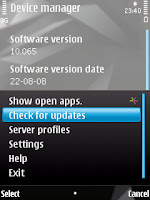The reason for these two questions is that one of my friends asked me recently: "That Nokia's Ovi, what is it? I would like to use it, but I don't know how and I don't know what I could do there." I explained to him shortly that Ovi is a place for accessing Nokia's different services. You can find maps, music, games, share pictures there and upload calendar, contacts and files. To be honest, this was a kind of lousy explanation. After this I started thinking a little more about Ovi.
Correct me if I'm wrong, but I believe Nokia's general idea is to offer a service where you find everything you need and you can access it with any device (pc, mac or phone). Maybe it could be described in a few words as "personalised multi-channel portal"? Personally I think that if something cannot be explained in a few sentences, it won't be a success among users.
This "personalised multi-channel portal" looks quite nice and if you synchronise your phone with Ovi, it can be an useful service.

I tried it once, just to check it out how it works with generic data and stopped using it. Reason for this is that I've have company confidential information in my phone and I really don't want to share it. I know Ovi should be safe, but still I don't want to take that risk. I believe this is a quite big question / threat for IT departments because syncrhonising is really easy.
I'm not saying that Ovi concept wouldn't become a success, but I must say there are still lots of work to be done. I've listed some of things that need to be improved before success.
- Too many user IDs and passwords. At the moment there isn't any general user ID and password for Ovi services, because it builds up from different services. Users won't use a service which need own credentials for Ovi (synchronisation), music, sharing pictures and games.
- Integration. Basically same as above, all services must be seamlessly integrated before it is usable. If I use a portal, I want to be able to use all services easily and smoothly.
- Common user-interface. I believe that a portal should have common user-interface because otherwise the usage of different services will be much more difficult.
- Logic. A service must be logical to use. I was really surprised when I went to Ovi.com, clicked Sign In and saw a page saying "contacts & calendar". My first thoughts were: "What did I do? I don't want to sign in to contacts & calendar, I want to sign in to Ovi".
- Useful services. Ask yourself why would someone create credentials and start using this service daily and suggest it to his/her friends? When Ovi is "fully personalised multi-channel portal", I believe this is possible.
Don't get me wrong, there are also good features already existing, for example easy syncrhonisation and your content from your Share on Ovi comes automatically to your Ovi portal. Atleast I don't remember giving any Share on Ovi credentials to Ovi, probably sharing is done by checking e-mail addresses.
A more difficult question is: "How Nokia will make money out of this?" If I would need to guess, I would mention three different approaches:
- Offer first free services, then start charging. This seems to be the case in the Maps for example. Most of the new handsets have a free license for a year, after this the user needs to purchase a license.
- Offer first free services, then start charging small amounts. Almost like previous, but with smaller amounts of money, e.g. a few euros (even cents?) per month.
- Bundle the price to handset. Nokia is trying this with Comes with Music and everyone is waiting for the results.
I suggest that you check Ovi out yourself and make your own decisions. So, go to Ovi with your desktop or mobile browser and explore it.

















